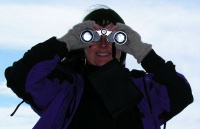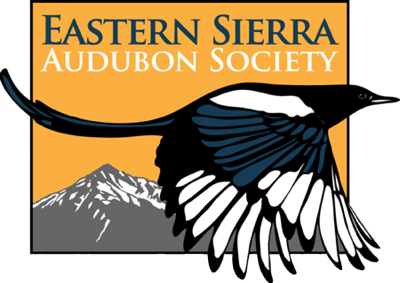
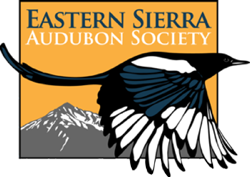
Sierra Wave
Newsletter
Volume 34, Number 4
March-April, 2017
Sierra Wave Newsletter
Volume 34, Number 4
March-April, 2016
Contents
- Events:
- Features:
- News:
- Reports:
- Business
Events
ESAS Evening Program:
April 19: Ripple Effects - using sound to study the effects of introduced trout on bird populations around alpine lakes, with Mary Clapp

Mountain Bluebird, with food, photo by Gail Patricelli
Wednesday, April 19, 2017, U.S. Forest Service/BLM Building in Bishop, 7:00pm
Our April program will be held at the U.S. Forest Service/BLM Building in Bishop on West Line Street, near the DMV. Doors open at 6:30, with the presentation starting at 7:00pm.
Guest speaker, Mary Clapp, will discuss her ongoing research on the impacts of introduced trout
on the native bird community in the high-elevation lake basins of Sequoia-Kings Canyon
National Parks (SEKI). Non-native trout prey heavily upon aquatic insects, potentially
outcompeting native insectivores (including birds and bats) for an important food source and
altering their foraging behavior, fitness, and reproductive success in unknown ways. Her work
studies this connection between water and land by using acoustic recorders to remotely capture
lakeside activity by birds and bats, and comparing this technology with traditional survey
methods. In this talk, she will give a brief overview of the acoustic methods she has used to
compare bird activity at fish-containing and fishless lakesides and review preliminary analyses.
Her work is made possible by substantial collaboration with SEKI and the Natural Sounds and
Night Skies Division of the National Park Service.
Mary Clapp is currently a fourth-year Ph.D. student in the Graduate Group in Ecology at UC
Davis. Though native to Maryland, she migrated to the wilderness of the Sierra Nevada in 2010,
where her academic imagination took flight and where she has continued to naturalize. When she
is not in the alpine zone eavesdropping on birds and bats, she can be found at lower elevations
exploring riparian corridors, cliffsides, boulder fields, and hot springs (or at her computer in
Davis).
Questions/comments: programs@esaudubon.org; For more information contact Erin Nordin (email erin@esaudubon.org). Also, check back to the programs page for updates to the list of future speakers. Everyone is welcome to attend all programs!
ESAS Field Trips and More for March and April
March 4, Saturday, 9am-2pm, Bishop: Birding Field Trip with Jon Dunn
Part of the Inyo Council for the Arts' Community Reads program this year, Cultivating Connections through the Natural World: a Community Celebration of Birds and Birdwatching.
World renowned ornithologist and world birding tour leader, Jon Dunn, will lead a Northern Inyo County birding tour. WAITLISTED
SPACE IS LIMITED. Call Inyo Council for the Arts at 760-873-8014 to RSVP.
Please note: this event is at capacity. RSVP’s will be added to the wait-list and contacted if a space opens.
Back to Top
March 25 Saturday, 9am-1pm, Owens Lake: The Miracle of Migration with Mike Prather
Part of the Inyo Council for the Arts' Community Reads program this year, Cultivating Connections through the Natural World: a Community Celebration of Birds and Birdwatching.
Join local bird expert Mike Prather to witness the annual migration on Owens Lake.
SPACE IS LIMITED. Call Inyo Council for the Arts at 760-873-8014 to RSVP.
Back to Top
April 1, 8am: Raptors Field Trip with Ron Oriti

American Kestrel, photo by Ron Oriti
Ron Oriti has given two very popular presentations for Eastern Sierra Audubon featuring his gorgeous raptor photos. There are 17 different raptors that are typically found in the eastern Sierra - come join Ron in the field to spot some of these beautiful birds!
Limited to 20 participants - call Bart Godett at 760-876-0317 to reserve your spot.
We will meet at 8am on April 1st on the corner of Wye Road and Spruce Street (corner behind K-Mart in Bishop) where we can carpool as desired.
We will be driving to various spots around the Laws area and north to Benton. We expect to be back by noon. Bring binoculars, field guides, water, and snacks.
Ron Oriti is a retired Planetarium Director and astronomy teacher whose love of nature and the outdoors brought him to the Eastern Sierra. With the aid of the digital camera he has specialized in photographing local landscapes, wildflowers, dragonflies, butterflies, lizards, raptors, and other birds.
For Questions/More information, contact Bart Godett at 760) 876-0317
Back to Top
 Antelope Valley/Topaz Lake Birding, First Friday of each month at 9am - Beginners Welcome! (Binoculars and bird books provided)
Antelope Valley/Topaz Lake Birding, First Friday of each month at 9am - Beginners Welcome! (Binoculars and bird books provided)
- Friday, March 3, leaving at 9am from the Sweetwater Coffee Shop in Coleville
- Friday, April 7, leaving at 9am from the Sweetwater Coffee Shop in Coleville
Join us as we look for resident and migrant species of birds throughout the beautiful Antelope Valley, including along the shores of Topaz Lake (in the northern part of Mono County).
Please Note:
Starting in January 2017, we will be meeting at 9am instead of 8am.
Leader: Elena Espinosa (30+ years of birding experience)
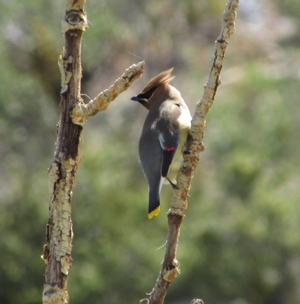
Cedar Waxwing in Mountain Gate Park
Photo by Dick Padgett
Lately (Nov-Dec) we've been seeing an assortment of buteos and accipiters including Ferruginous Hawks, Sharp-shinned Hawks, Northern Harriers and a Prairie Falcon. We continue to see the occasional American Dipper at Mountain Gate Park. The Loons in winter plumage are back at Topaz Lake. The Northern Flickers are making their way through along with Juncos and White-crowned Sparrows. We're seeing the resident Great-horned Owl almost every time in his group of Cottonwoods that he likes to hang out in on Cunningham Lane.
I hope to see you for breakfast around 8am on the first Friday of the month and then head out for the birding around 9am.
When: 9:00am on the first Friday of each month
Where: Sweetwater Coffee Shoppe at 107537 Hwy 395 in Coleville. The coffee shop makes delicious beverages and serves croissant, burrito and bagel breakfasts. Arrive at 8 to order before we head out at 9.
Contact Elena with questions or for more information: 928-300-8088 or espinosa2015@gmail.com.
Back to Top
 Monthly Bishop Paiute Tribe COSA, Bird Walk and Census Dates:
Monthly Bishop Paiute Tribe COSA, Bird Walk and Census Dates:
- Saturday, March 11, 8:30am
- Saturday, April 8, 8:30am
[Ed. Note: COSA walks are held on the second Saturday of every month, unless otherwise indicated]
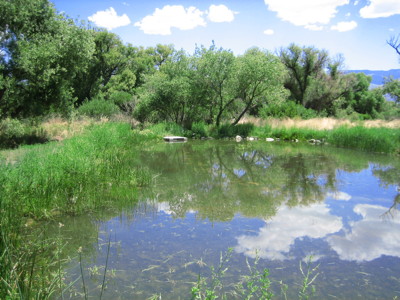
Spring has sprung in the COSA!
Unless otherwise indicated, our COSA bird walks will all be the second Saturday of the month, except (sometimes) for December, because we will have it coincide with the Christmas Bird Count. During June, July, August, and September they will start at 7:30 instead of 8:30. Watch the monthly email update, this field trips page, or local media for confirmation, updates on leader(s) and meeting time. Or, contact Hillary (below), or if you just show up at 8 or so, you'll probably find us!
The Conservation Open Space Area is being developed for wildlife and the community by the Bishop Paiute Tribe. We'll be keeping species lists and observing behavior as well as identifying birds, for the purpose of creating bird lists for the site. For more information, read this article on the COSA in the March-April 2013 Sierra Wave newsletter. There have been surprises every month so far - come find out what new birds we'll see next time - maybe you'll add toour bird list on e-Bird!
All are welcome - these walks are for birders of ALL LEVELS, beginners included! We will bring extra binoculars and field guides to share. If you'd like to print out a bird checklist, with blanks for adding your own discoveries, you can download that here: COSA Bird Checklist trifold (pdf)
Please meet at 7:30am in June-September, or 8:30am during October-May at the BLM/Forest Service Building on West Line Street in Bishop. Contact Hillary Behr for more information, or if you are interested in leading a future monthly walk: hillarybehr@yahoo.com.
Back to Top
April 15 Saturday, 9am-1pm, Owens Lake: The Miracle of Migration with Mike Prather
Part of the Inyo Council for the Arts' Community Reads program this year, Cultivating Connections through the Natural World: a Community Celebration of Birds and Birdwatching.
Join local bird expert Mike Prather to witness the annual migration on Owens Lake.
SPACE IS LIMITED. Call Inyo Council for the Arts at 760-873-8014 to RSVP.
Back to Top
Owens Lake 2017 Spring Big Day - Monday, April 24th
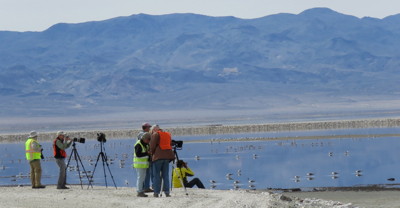
Owens Lake Big Day Birders
The Owens Lake Spring Big Day will be Monday, April 24th. We will gather at 7AM at the Diaz Lake County Park parking lot 3 miles south of Lone Pine on Highway 395. Volunteer citizen scientists will partner with Los Angeles Department of Water and Power biologists to census all of the birds on Owens Lake Important Bird Area on a single peak spring date. Spring numbers are normally quite high and over 100,000 birds is a real possibility. Intermediate birding skills are helpful, but extremely interested beginners are welcome – we are always recruiting and training. Please RSVP to Mike Prather.
Back to Top
2017 Owens Lake Bird Festival - April 28-30, 2017
Register Early in order to secure the trips you want!
Join Friends of the Inyo and our partners for the 3rd Annual Owens Lake Bird Festival on April 28-30.
Experience the resounding return of thousands of migratory birds to Owens Lake, a designated Important Bird Area by the National Audubon Society. The Festival kicks off Friday, April 28 with a reception at the Museum of Western Film History in Lone Pine. Join local experts on birding and natural history tours on and around Owens Lake on Saturday and Sunday April 29 and 30. The keynote speakers at Saturday evening’s reception this year will be iconic Owens Valley birders Tom and Jo Heindel.
Early registration for Friends of the Inyo members starts February 1 and general registration opens February 15.
See the Friends of the Inyo Owens Lake Bird Festival page for more information and registration.
Back to Top
Back to Top
Features
Community Reads focuses on Birds and Birding this year!
Inyo County Community Reads, now in its 9th year, celebrates and promotes literacy and community through reading. This year, the program is focusing on the theme of birds and birdwatching. In addition to the community events listed below, the Inyo County Superintendent of Schools office is sponsoring events in county schools, as well as providing classroom sets of books for schools throughout the county. Eastern Sierra Audubon is helping by incorporating its Birds in the Classroom programs, monthly COSA walks, and more into the events.
Community Reads 2017 will feature, for the first time, a selection of books for different age groups and interests. The 2017 program will focus on literacy and community involvement, will have expanded activities in Inyo County schools, and will support the ICSOS kindness initiative.
The books for this year's event are listed on the event's GoodReads site here: www.goodreads.com/group/bookshelf/208749-community-reads-2017-birds and are all available at Spellbinder Books in Bishop.
An abbreviated list of the program's events are listed below - see the website for more detail!
- March 1: Kick-off Party – Wed. 3/1 – 5:30pm – Inyo Council for the Arts (ICA)
- March 4: Birding Field Trip with Jon Dunn – Wait-listed
- March 11: Eastern Sierra Audubon Bird Walk – Sat. 3/11 – 8:30am
- March 11: Community Art Day – Sat. 3/11, 10:00am-2:00pm – Jill Kinmont Boothe School.
- March 18: Family Movie - Happy Feet, 3:00pm – ICA and Lone Pine Film History Museum
- March 21: Book Discussion: Hoot – Tue, 3/21 – 7:00pm-8:00pm – Spellbinder Books
- March 25: The Miracle of Migration: Owens Lake – Sat 3/25 – 9:00am-1:00pm
- April 6: Storyboarding Workshop with Janell Cannon – Thurs. 4/6 – 5:30pm
- April 8: Eastern Sierra Audubon Bird Walk – Sat. 4/8 – 8:30am
- April 8: Eastern Sierra Land Trust Pollinator Workshop – Sat. 4/8 – 9:45am-12pm – ICA
- April 8: Community Art Day – Sat. 4/8 – 10:00am-2:00pm – Big Pine Schools
- April 12: Film: Winged Migration, 6:30pm at ICA & Lone Pine Film History Museum
- April 15: The Miracle of Migration: Owens Lake – Sat 4/15 – 9:00am-1:00pm
- April 25: Book Discussion: Wabi – Tue. 4/25 – 7:00pm-8:00pm – Spellbinder Books
- April 26: Book Discussion: The Thing With Feathers, 6:30pm at Spellbinder Books
- April 28-30: Owens Lake Bird Festival – Fri. 4/28-Sun. 4/30 – Lone Pine

Back to Top
Phainopepla
[Click on any photo to see larger, or all in a slideshow]

Male Phainopepla - photo by Kelli Heindel
After studying birds for over half-a-century, we have to fess up that every time we look closer at a species, the more interesting it becomes. The closer you look, the more you see, and the more amazed you are at just how little you knew! Sometimes you find out that there is something about a species that absolutely nobody on the entire planet knows! This latter point is the case with our subject bird, the Phainopepla!
Although not a 'proper' flycatcher in the flycatcher family Tyrannidae, the Phainopepla is in a family called Ptilogonatidae commonly referred to as Silky-Flycatchers but more closely related to Bulbuls. Of the four species in the world, only two are found in North America and the other two are south to Panama. The most fascinating thing is that with all the bird studies over the last two centuries there is a mystery regarding their breeding behavior.
Phainopeplas are native to the Southwest United States and much of Mexico. In the deserts where their favorite food source, the mistletoe berry, is plentiful, the Phainopepla is common. In Inyo County, mistletoe berries abound in the southeast corner with many records from the Amargosa drainage, China Ranch, Crystal Spring, Death Valley Junction, Resting Springs, Shoshone, and Tecopa. But we also have records from Death Valley National Park and the Owens Valley, places with few if any mistletoe berries. Intriguing, huh!
Tecopa Triangle
Sadly, banding data do not exist for Inyo County and none have been cited in the many articles we've read. Maybe we've missed the one that has the answer!?! We can say that Phainopepla are common in the "Tecopa triangle" from October through May and are rare to zero June through September. Breeding data exist January through March with large numbers of families in April, decreasing in May, and then bye-bye.

Phainopepla Abundance Data in the "Tecopa Triangle"
Death Valley National Park
But wait, what is happening in Death Valley National Park? A few records occur November through April, numbers increase significantly in late April through June, highly reduced in July and August, increase again in September and October. Remember that data is the result of two entities…a bird and a birder. July and August are months with few birders in the Park so the few data reflects that reality, not the fact that Phainopepla are gone, but they might be. Breeding in the Park is documented in May and June.

Phainopepla Abundance Data in Death Valley National Park
Owens Valley and Adjacent Mountains
And then there is the Owens Valley and adjacent mountains with a nice supply of bird data gatherers… sometimes called birders but who work harder documenting what they find. Few records have been collected from October through April and this is indicative of reality since bird data gatherers bird all year! Then in May the shiny black and garnet objects arrive! Breeding is primarily May through July with departure about mid September. Breeding locations are Ninemile Canyon in the southern Sierra Nevada, Hogback and Lone Pine Creeks and Edward's Field near Lone Pine, near Big Pine, and Owens River and Birchim Canyon both north of Bishop.

Phainopepla Abundance Data in the Owens Valley and Adjacent Mountains
So there is a clear picture of when and where the Phainopepla are and when they breed. But some authors are beginning to question the conventional wisdom that they breed in deserts and then move up into riparian woodlands and oaks and breed again. That's an intuitive answer. But where's the proof? It has been suggested that these could be two populations in Mexico with one population moving into the deserts early in the season to breed and then return to Mexico as the second population moves into the more northern, cooler and more moist habitats to breed and then depart to the southern U.S. and Mexico to spend the winter.

Female Phainopepla - photo by Kelli Heindel
As if that isn't fascinating enough! The desert breeding Phainopepla defend their territories like terriers and beware any intruders. The more northern breeding Phainopepla believe in kum-ba-yah and nest in loose colonies, have overlapping home ranges, and join together to mob species like Scrub-Jays. "The question of whether the remarkable behavioral flexibility of the Phainopepla is exhibited by individuals or by separate populations of birds remains an unresolved and pressing issue." This paragraph thanks to Chu and Walsberg 1999:2.
It seems that the solution is so simple! Band-em! Band them in the Tecopa triangle and then pack up your nets, poles, and boxes and move to the Owens Valley. Anybody need a Masters or PhD in Biology?
Chu, M. and Walsberg, G. 1999. Phainopepla (Phainopepla nitens). In The Birds of North America, No. 415 (A. Poole and F. Gill, etd.). The Birds of North America, Inc., Philadelphia, PA.
By Tom & Jo Heindel
Back to Top
News
Scholarships Available for local Graduating Senior High School Students!
 Are you (or do you know) a high school senior who is interested in applying for the Eastern Sierra Audubon Society’s 2017 scholarships? Two $500 scholarships will be awarded, one to a Mono County and one to an Inyo County senior.
Are you (or do you know) a high school senior who is interested in applying for the Eastern Sierra Audubon Society’s 2017 scholarships? Two $500 scholarships will be awarded, one to a Mono County and one to an Inyo County senior.
We are looking for someone who has demonstrated through current study and activities and whose future studies, volunteer work and career ambitions will promote the National Audubon Society’s mission:
“To conserve and restore natural ecosystems, focusing on birds, other wildlife and their habitats, for the benefit of humanity and the earth’s biological diversity.”
You can be studying art, science, education, advocacy, habitat conservation, journalism, literature, law, public policy, environmental justice or outdoor recreation (or maybe something we haven’t thought of!). Volunteer work as a student is a plus, but not a requirement. Qualified applicants are required to attend college/higher education full-time starting in Fall 2017-2018. On-line applications are available at: esaudubon.org/education/scholarships/.
We welcome you to apply for this special opportunity and will be accepting applications until May 10, 2017. Deadline has to be strictly enforced so we can meet our deadlines with your school.
For more information, contact Ann Hoffmann: 760-937-1862, scholarship@esaudubon.org.
Good Luck!
Ann Hoffmann
Back to Top
Annual Audubon Yard Sale, Saturday, April 29 2017
Save the date AND your donations!
On Saturday, April 29, 2017, ESAS is holding a yard sale to help fund our scholarships. We are in need of items to sell at the yard sale, so please start settings things aside. Enlist the help of friends and neighbors, too!
Joan Nash has offered her yard and items can be dropped off at her home beginning on Monday, April 24, 2017. Call Joan at 760-873-3442 before dropping off items for the yard sale.
Spring is a good time for cleaning out closets, garage shelves, attics, and finding long forgotten boxes of treasures. It is also a time when the young scholars of Mono and Inyo Counties prepare to head off to a new collegiate chapter. These students will benefit from a boost in funding their endeavors. With that in mind, Eastern Sierra Audubon Society is moving forward with raising money for scholarships to two graduating seniors in 2017.
If you have questions, contact Ann Hoffmann at hoffmann@qnet.com/760-937-1862. Your help is very much appreciated!
All proceeds from the yard sale go to supporting our ES Audubon high school scholarship fund.
Back to Top
Mono Lake Needs YOU!
Be a volunteer at Mono Lake this summer and meet
visitors from all over the world while sharing your
knowledge of the Eastern Sierra.
Volunteers are very important to the visitor
experience! There are opportunities to rove and
answer questions at the shore and/or visitor center,
guide group tours and help with trail maintenance
and weed removal. An 8 hour commitment per
month, June through September, is requested.
Participants must be at least 18 years old, able
to walk short distances and stand for 2 hours in
sunny locations.
Free Training Sessions: June 2 - June 4, 2017
Friday & Saturday 9am-4pm, Sunday 10am-5pm
Volunteers are required to attend all training sessions.
Please contact Jessica Horn at Jessica@monolake.org or
call 760-647-6595 for more info or to sign up.
Click here for a flyer to share!
Back to Top
Reports
Report: 2016 Bishop Christmas Bird Count
The 35th annual Bishop Christmas Bird Count was December 17, 2016. Forty-seven birders counted every bird in the 15-mile diameter CBC circle centered on the intersection of Ed Powers Road and Red Hill Road. The circle encompasses Round Valley, Pleasant Valley Reservoir, the Owens River to Laws, East Line Street to the River, south to New Wilkerson, all of downtown Bishop and West Bishop, up Bishop Creek to Big Trees Campground, and the Buttermilks. Weather was cold and breezy in the morning with a low of 14 F with 20 mph winds, warming in the afternoon to 48 F with calm winds. Skies were clear. Birders in eleven teams collectively tallied 104 species and a total of 8156 individual birds. Overall, bird numbers and diversity were below average, with many teams reporting fewer birds than in recent years. Open water and creeks were not frozen, so waterfowl numbers were above average.
A good selection of rarities were found, notably two species never recorded on the Bishop CBC: 1) a TURKEY VULTURE over Bishop, and 2) a BELL’S VIREO at Millpond. Nearly all Turkey Vultures vacate the Owens Valley between November and February. Decades ago, Bell’s Vireo nested in the Owens Valley, but there have only been a few observations since. The Bishop City Park hosted three species of geese, four Aleutian CACKLING GEESE, a SNOW GOOSE, and a ROSS’S GOOSE, as well as a PALM WARBLER which was first found November 28. This year established new high counts for NORTHERN SHOVELER (204) and DOUBLE-CRESTED CORMORANT (13). The team covering the Owens River encountered a record 21 SORA among the reeds and riverbanks. A BARN OWL on a Round Valley phone pole was a good find, as well as a BURROWING OWL along an old canal north of Bishop. Two species of hummingbirds are being found with increasing regularity, ANNA’S HUMMINGBIRD (15) and COSTA’S HUMMINGBIRD (2), mostly at feeders. A female WILLIAMSON’S SAPSUCKER at Plant Four was noteworthy, as it has only been found on two other Bishop CBCs. For the second year in a row, WESTERN BLUEBIRD (43) outnumbered MOUNTAIN BLUEBIRD (9), and now seems to be the expected wintering bluebird around Bishop. In the past 15 years, ORANGE-CROWNED WARBLERS have been on the increase, with 29 tallied this year. One CHIPPING SPARROW and one Gray-headed DARK-EYED JUNCO at Rocking K were unexpected surprises. Sparrow numbers were above average with a new high count for LINCOLN’S SPARROW (76) and GOLDEN-CROWNED SPARROW (5).
TRENDS – compared with the past thirty-four Bishop CBCs, here’s how 2016 compares:
BLACK-BILLED MAGPIES numbers continue to be depressed with only 55 found this year. In the late-1990’s through 2005 numbers in excess of 150 were common.
GEESE – For the second year in a row, no CANADA GEESE were found.
EURASIAN-COLLARED DOVES made their debut on the Bishop CBC in 2004 and are now ubiquitous. This year reached 149.
Between 1982 and 2002 no ANNA’S HUMMINGBIRDS were found on the Bishop CBC. Since then, numbers have increased nearly every year. This year seven teams tallied a total of 14 birds.
Many thanks to all the talented and generous people who make the Bishop CBC possible! A special thank you goes to Steve at the Bishop Country Club, Destin at the City of Bishop, and Kay Wilson for hosting the post-count tally.
The 2017 Bishop CBC will be Saturday, December 16, 2017. SAVE THE DATE!
Chris Howard,
Bishop CBC Compiler
Back to Top
Field Trip Report: Big Pine Winter Wildlife Tour
On 25 February, the 2017 Winter Wildlife Tour began at Glacier View Campground at the corner of Highway 395 and Highway 168 at the north end of Big Pine at 0800hrs. This annual tour is sponsored by the Eastern Sierra Audubon Society and permission is given by Los Angeles Dept. of Water and Power to take a group onto their land. The publicity, both on the radio and in the paper for the last couple of weeks, was the best the field trip had ever had. But today we had the lowest turnout we have ever had in over the 20 years that we have led this trip. The weather conditions were the best we could have hoped for…cold but no rain or snow! There were just 10 participants other than us and half were from the Bird Study Group. We wondered if it was concerns over the weather and road conditions after weeks of rain and snow that cut the size to one-third the norm. On Friday, we had made another run to check out the roads to insure that our route would be passable. The other concern is always wind and it was relatively still until our last stop when it began to blow hard. We began with introductions and discussed where we would be going and prepared the drivers for what they would see and which side of the road to drive on. Follow your leaders!!! Unless they disappeared into the abyss!
We handed out bird lists and maps of our route and headed to our first stop, Klondike Lake. The water level was very high and overflowing the road to the south. The LADWP is spreading water in the valley because we have had so much rain that their reservoirs are full and there is insufficient storage space in existing facilities. From a distance we could see a floating flock of 18 American White Pelicans, a few species of expected ducks, and we found an adult Black-crowned Night-Heron tucked into the reeds along the north shore. Water covered the road so we couldn't proceed, as in past years, to the north side of the lake. We returned to Hwy 395 and headed south to Reynolds Road. We checked the Great Blue Heron rookery and it was still vacant with three old dilapidated nests barely hanging on in the cottonwoods. Six roosting Turkey Vultures were found nearby. We continued to County Road and turned northwest to Warren Lake where we found a duck bonanza with ten species, all expected except for five Hooded Mergansers (1 male, 4 female). Two Greater Yellowlegs were found sneaking around on the far side of the lake. At least four California Mule Deer were seen as they were about to cross the ridge just to the west of Warren Lake.
We returned to HWY 395 and crossed it turning south on the Big Pine canal road. Few birds were seen in the northern section but a Say's Phoebe flitting about caught our attention. We turned east onto Steward Lane and had an adult Ferruginous Hawk fly across the road, pick up a thermal, and quickly rise on the warmth becoming a small object before getting off it it's private elevator and returning to give the group another beautiful view. We estimated about 200 Mountain Bluebirds in the fields and one Prairie Falcon sat atop a pole allowing good views. A U-turn at the bridge and we returned to the canal road where we headed south and shortly had another Say's Phoebe. The fields were barren and few raptors were found. Shortly we made a right to cross Highway 395 and then took the North Fish Springs Road, stopping at the bridge. Song Sparrows and a Marsh Wren were vocalizing in the reeds and then a whistled imitation of a Sora was quickly followed by two real Soras responding! We walked around the buildings and searched the canal turning up the expected species. The wind started to pick up and we wondered what Tinemaha Reservoir would be like. We drove to the lower overlook and decided to try it there where there is some protection from the strengthening northern wind. A beautiful male Common Goldeneye was found along with a good-looking Common Loon and an American Kestrel hovering in one spot with the mountains behind him looking not unlike a hummingbird on steroids! The wind helped make up everybody's minds that they really didn't need to go up to the top today. We ended up with about 47 species; these were only the highlights. We'd like to thank a great group of people for help in pulling out some neat birds and making the morning such a special one for all of us!
By Tom & Jo Heindel
Back to Top
Taking Care of Business
Welcome New and Rejoining Members
Thank you to the members who recently joined or renewed their membership!
We'd like to take a moment to promote Chapter Memberships: You may not be aware of this, but 100% of Chapter Membership dollars stays locally in the Eastern Sierra, supporting local education, youth, conservation, and programs. If you don't need Audubon Magazine, consider joining or renewing as a Chapter-only member, or better yet, as both Chapter and National! We do get support from National Audubon, as well, so any membership helps, and is money well-spent toward bird and wildlife conservation and education, and we thank you!
Your membership donations help keep this chapter alive. We get 8-10 renewing members a month, and from 3-5 new members. Your membership dues make it possible for us to offer and support great educational and recreational events throughout the eastern Sierra. Thank you!
If you would like to join and help support Eastern Sierra Audubon, there are two ways you can do it:
- Join as a National Audubon Society Member, designating ESAS as your chapter affiliation. Includes Audubon Magazine subscription. This is $20 a year.
- Join as an ESAS Chapter-only Member for $20 per year. 100% of your donation stays here in the Eastern Sierra this way. Your chapter membership is a way to give back, and show your appreciation for all that ESAS does, and to help support our mission locally. Your membership helps pay for scholarships, programs, special events, education programs, research, and more. THANK YOU for your support!
Click Here for a membership form to join or renew!
Join National Audubon - your zip code will associate you with the chapter nearest you.
Back to Top
Keep in Touch!
All of our content is supplied by our awesome members... if you have any ideas about articles you’d like to see, or better yet, if you have anything to share for newsletter publication, whether an article, a news item, update, correction, poem, essay, artwork, photo, field trip report, neat birding experience, letter, etc, please send it, along with any comments or suggestions, to the newsletter
editor. We’d love to hear from you!
Please continue to send contributions to newsletter@esaudubon.org to make sure they get in the monthly email newsletters and on the website.
We send out about one email each month to remind you of upcoming events - if you are not
on our email list, please
add yourself so you don’t miss anything!
Thanks for reading, and happy birding!
Newsletter and Web Team
Back to Top
Calendar for March-April 2016 (and beyond!)
Back to Top

















